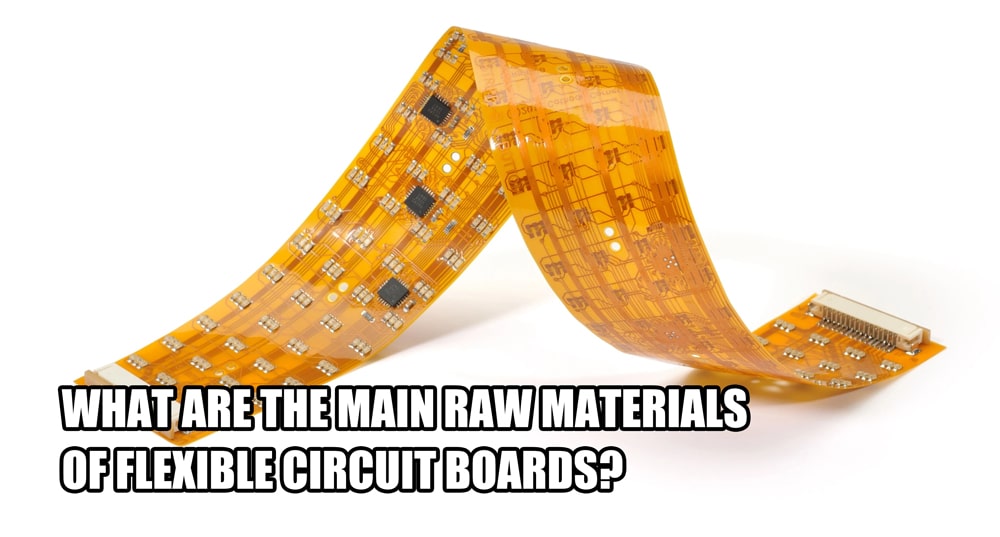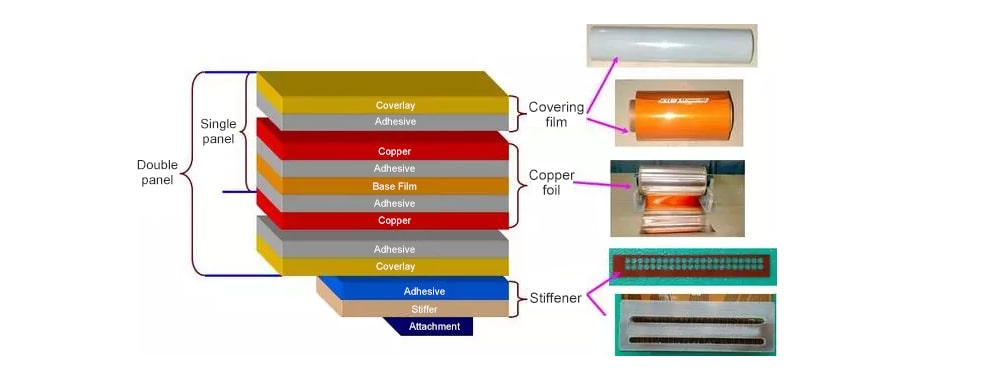What are the main raw materials of flexible circuit boards?
21 January 2025
Views: 2043
Flexible printed circuit board (FPCB), commonly known as flex PCB, are compact, lightweight, and highly flexible. They are extensively used in complex electronic devices such as smartphones, tablets, and laptops. So, what materials are used in flexible PCBs, and what are the primary raw materials?

What are the materials used in flexible PCB?
Copper Foil Classification:
Rolled Copper Foil: Rolled copper foil offers high ductility and bendability, making it suitable for FPCBs that require flexibility and bending. Its copper particle structure is flat, providing good ductility but relatively lower circuit density.
Electrolytic Copper Foil: Electrolytic copper foil is produced through electroplating, and its copper particle crystalline state is perpendicular to the substrate surface, making it suitable for creating fine lines. However, it has poorer bending performance and is commonly used in FPCBs with lower bending requirements.
Substrate Classification:
Polyester (PET): PET is a low-cost material with physical properties similar to polyimide but has lower temperature resistance. It is suitable for environments ranging from -40°C to 55°C and is primarily used in simple FPCBs.
Polyimide (PI): PI has excellent high-temperature resistance, withstanding immersion soldering up to 260°C/20S, and is widely used in military and commercial equipment. However, it is more expensive and susceptible to moisture absorption. Its thickness ranges from 0.5 to 2 MIL.
Additionally, new substrate materials such as Liquid Crystal Polymer (LCP) and Polyetherimide (PEI) are continuously being developed, offering higher working temperatures and physical strength. However, they come at a higher cost. The selection of materials also depends on the application environment and budget considerations.
The main materials used in flexible PCBs include:

Copper Foil
Copper foil comes in two types, electrolytic copper and rolled copper. Electrolytic copper has a smooth surface but is more expensive, while rolled copper is cost-effective but has a rougher surface. The choice of copper foil depends on different product requirements. The thickness of the copper foil determines the ability to create wire widths and spacing, with 1oz copper foil suitable for line widths ≥100um and 1/2oz or 1/3oz copper foil for achieving fine lines below 50um.
Substrate Film
Common thicknesses include 1mil and 1/2mil. The 1mil film offers better flexibility but is prone to deformation and damage, while the 1/2mil film is more fragile. Different industries may have different preferences, such as using 1mil film for medical devices and 1/2mil film for mobile devices to increase elasticity. Various film materials like Kapton and PI are commonly used, but their performance differs.
Adhesive
The adhesive thickness corresponds to the lamination method, such as rolling or curtain coating. The thickness affects the bonding strength and flexibility. Generally, 1-3mil is used for regular FPCs, while 3-5mil is used for products requiring higher strength.
Cover Film
The cover film protects the surface of the FPC and provides insulation. Common thicknesses include 1mil and 1/2mil. It safeguards the film from mechanical damage and quality issues. Different products may require different materials for the cover film, such as PP and PET.
Release Liner
The release liner prevents impurities from adhering to the adhesive before lamination, ensuring a smooth and even adhesive bond. Common materials for release liners include steel sheet, aluminum foil, and PET release liners.
Reinforcement Plate
Reinforcement plates enhance the mechanical strength of the FPC. Common thicknesses range from 3mil to 9mil. Materials like FR-4 and metal alloys are commonly used to increase hardness by 10-100 times.
EMI Shielding Film
The EMI shielding film protects the internal circuits of the PCB from external electromagnetic interference, especially in high-electromagnetic or interference-prone areas. Different metallic films like copper and aluminum can be chosen to control the shielding capabilities for different frequency ranges.
By selecting the appropriate materials, PCB manufacturers can design flexible PCBs with excellent performance and reasonable prices to meet different product requirements. With advancements in new materials and processes, the future applications of flexible PCBs are expected to become even more widespread.

